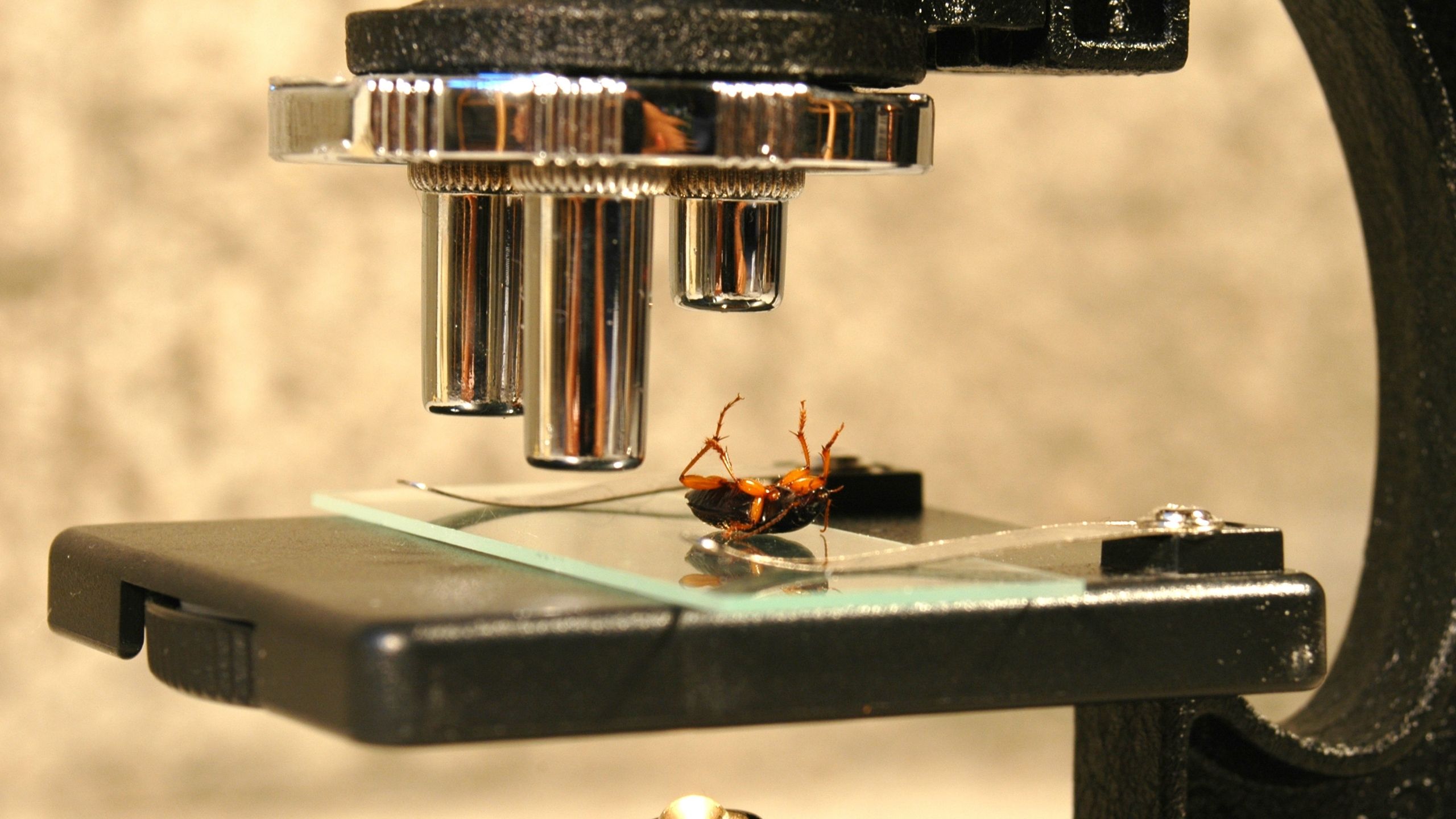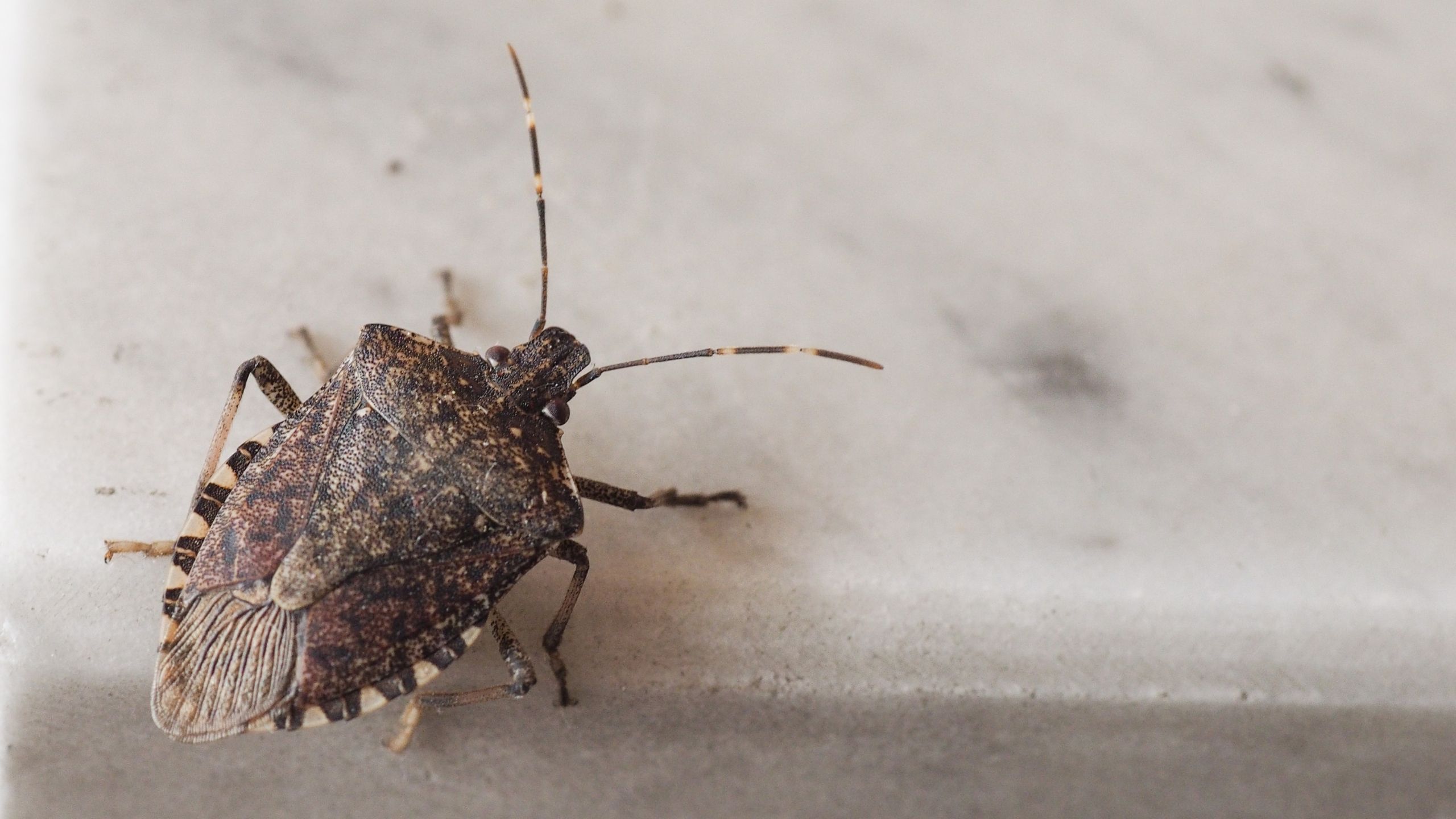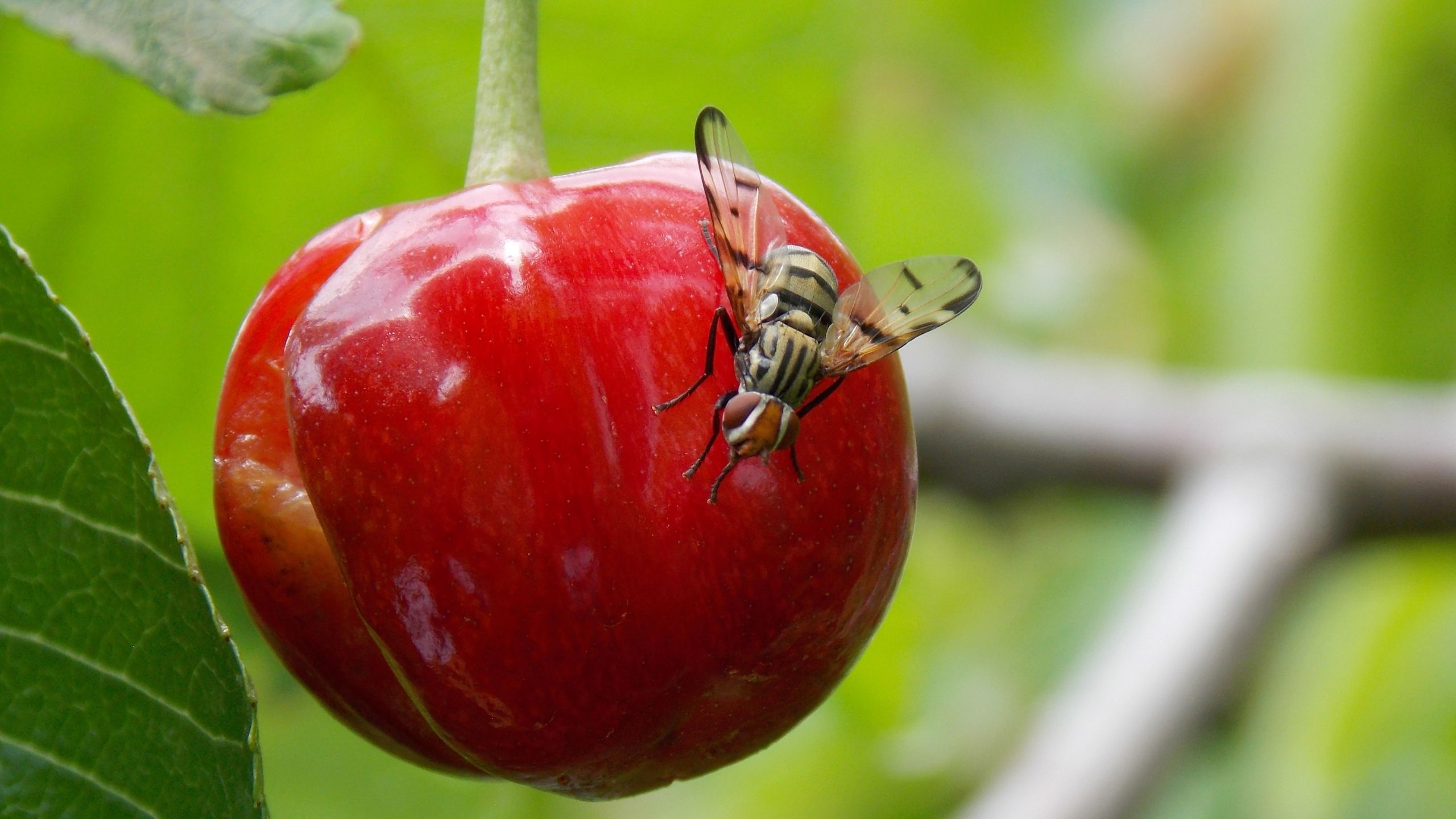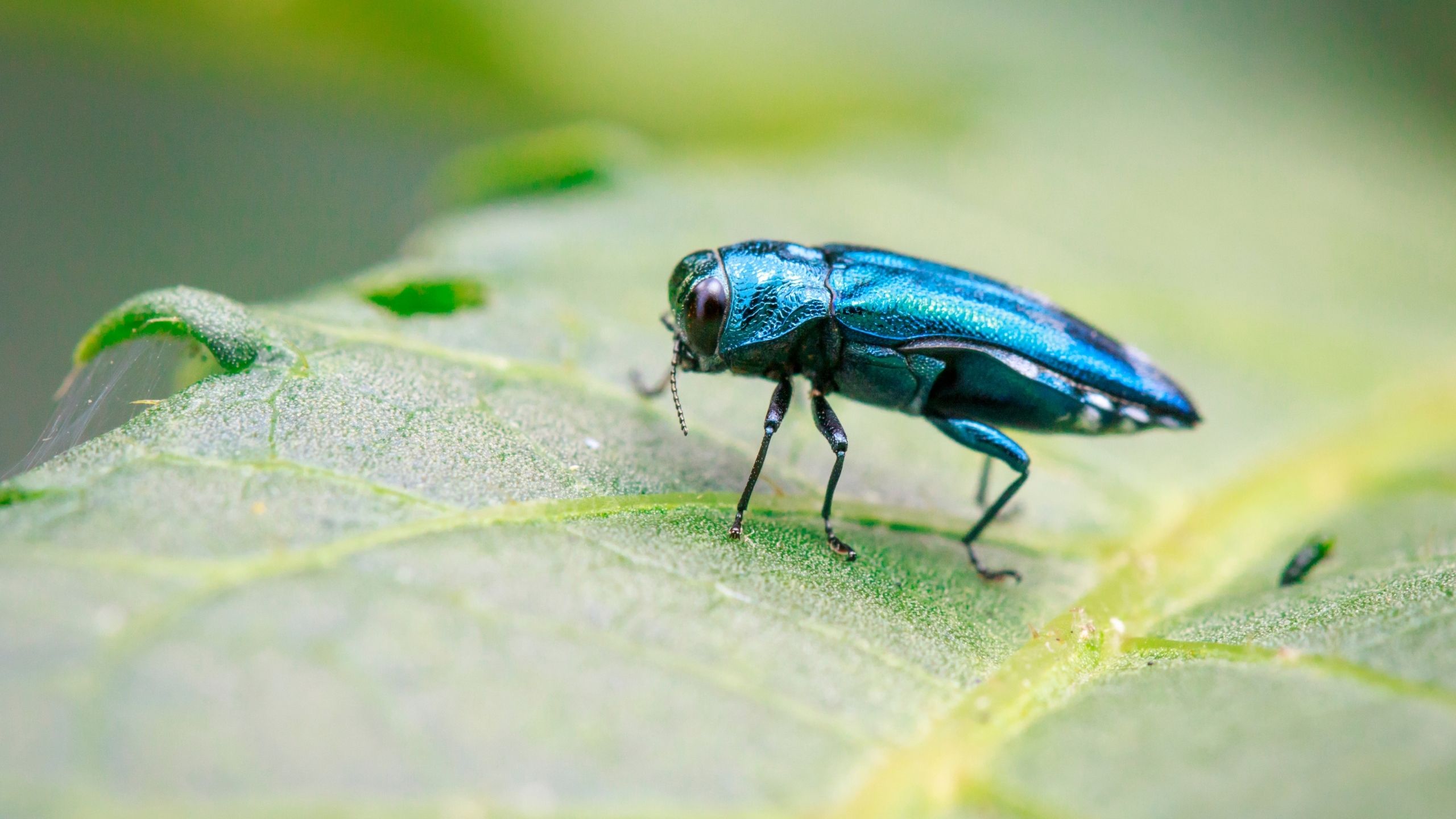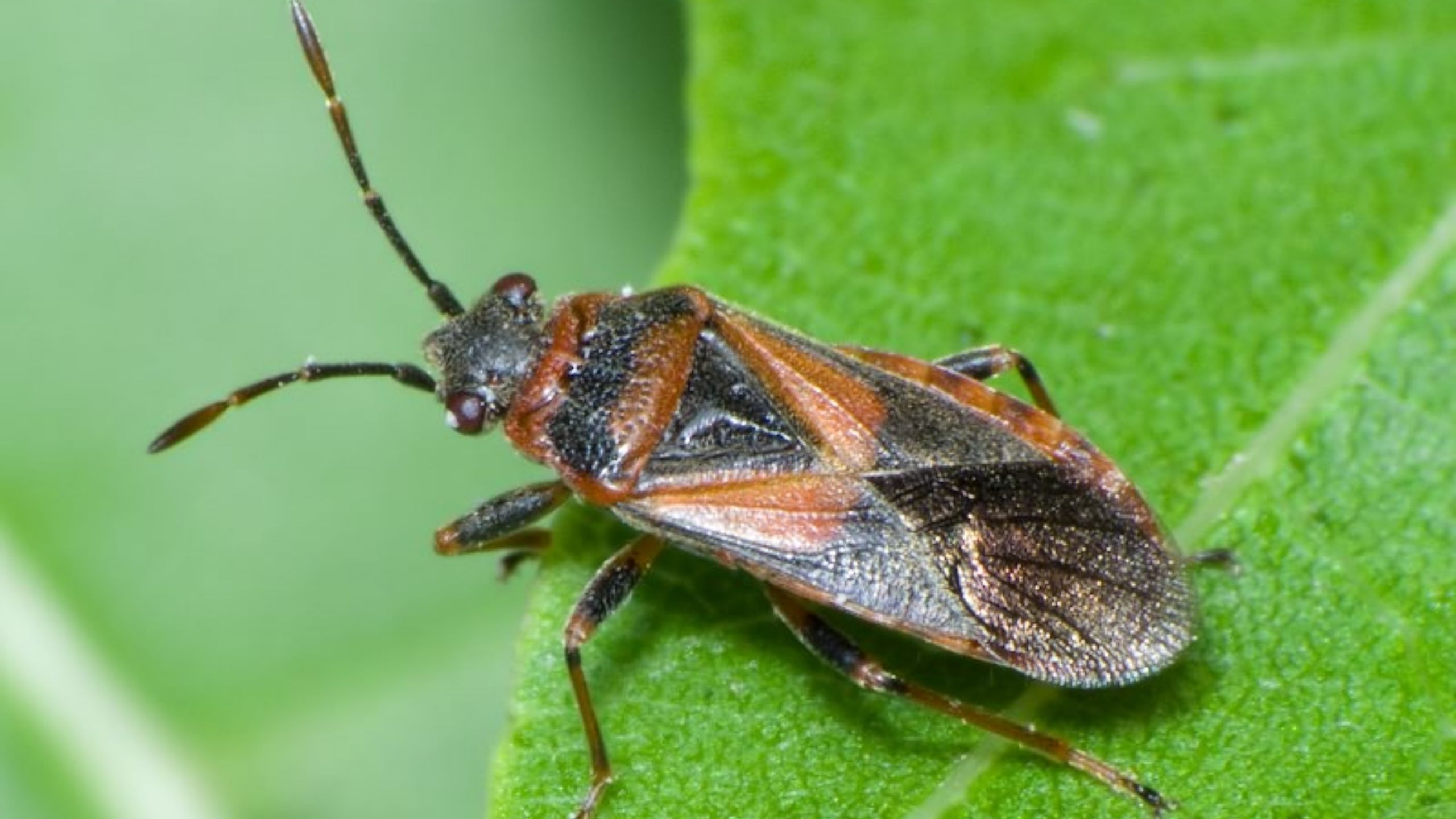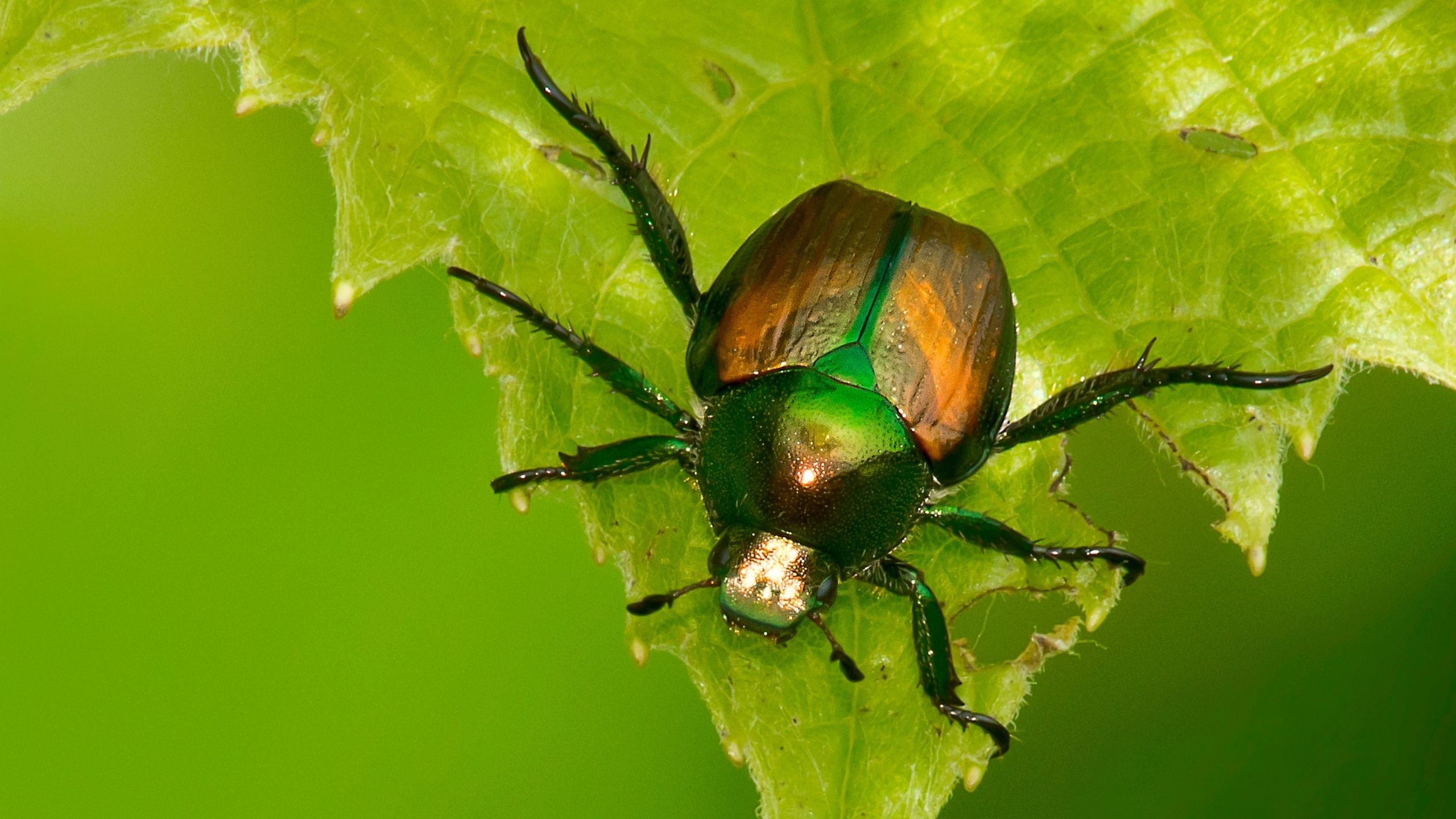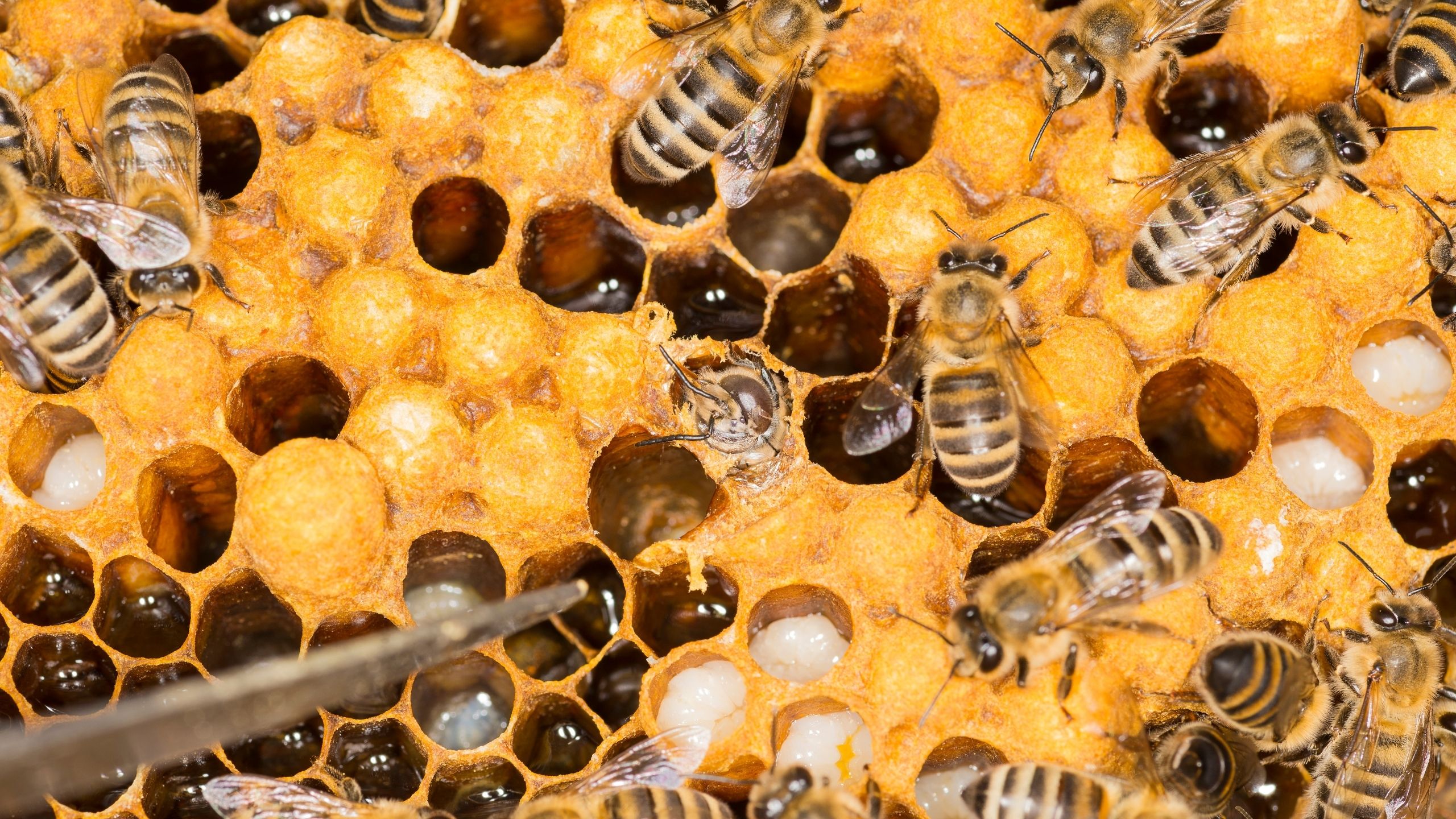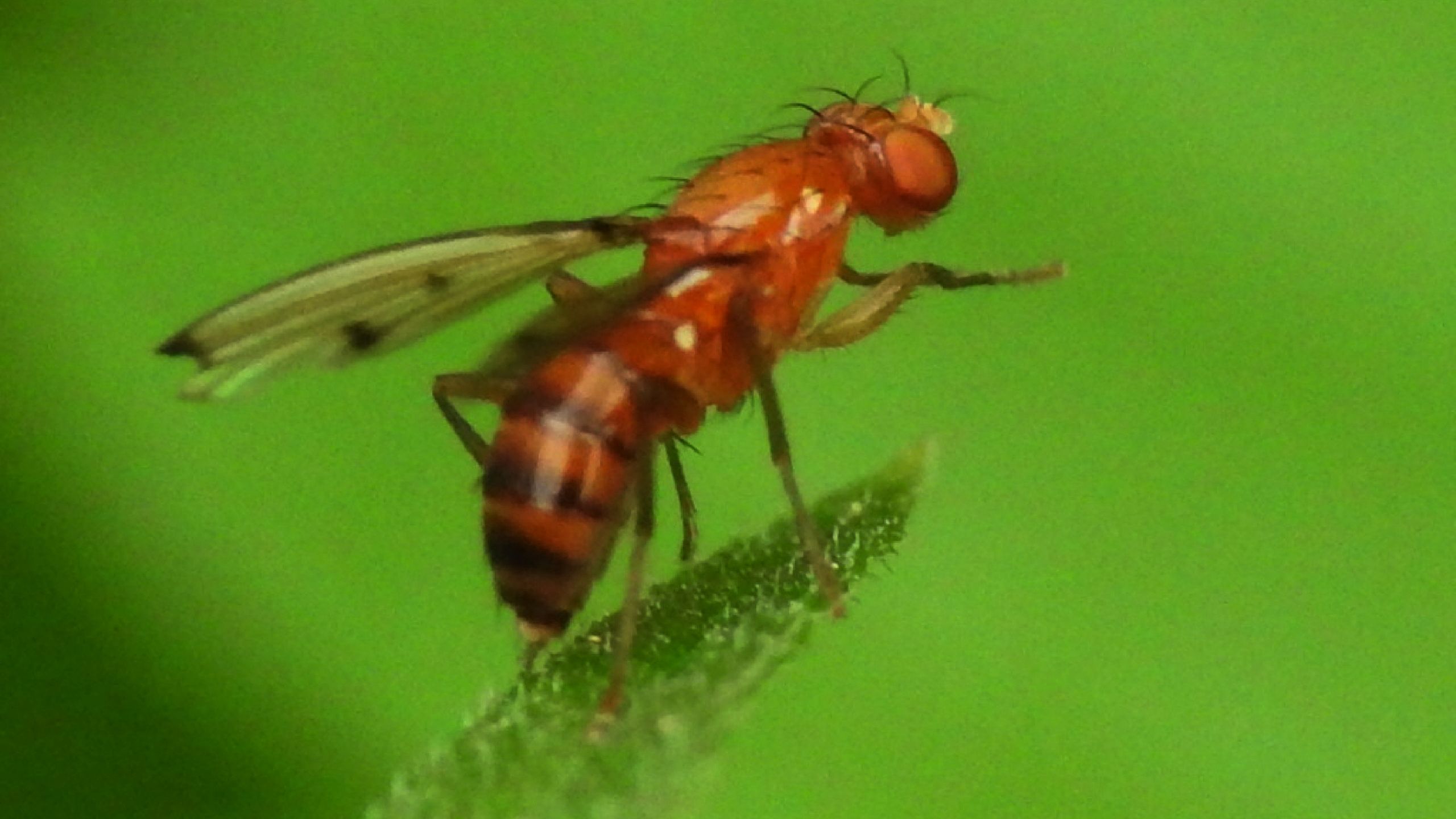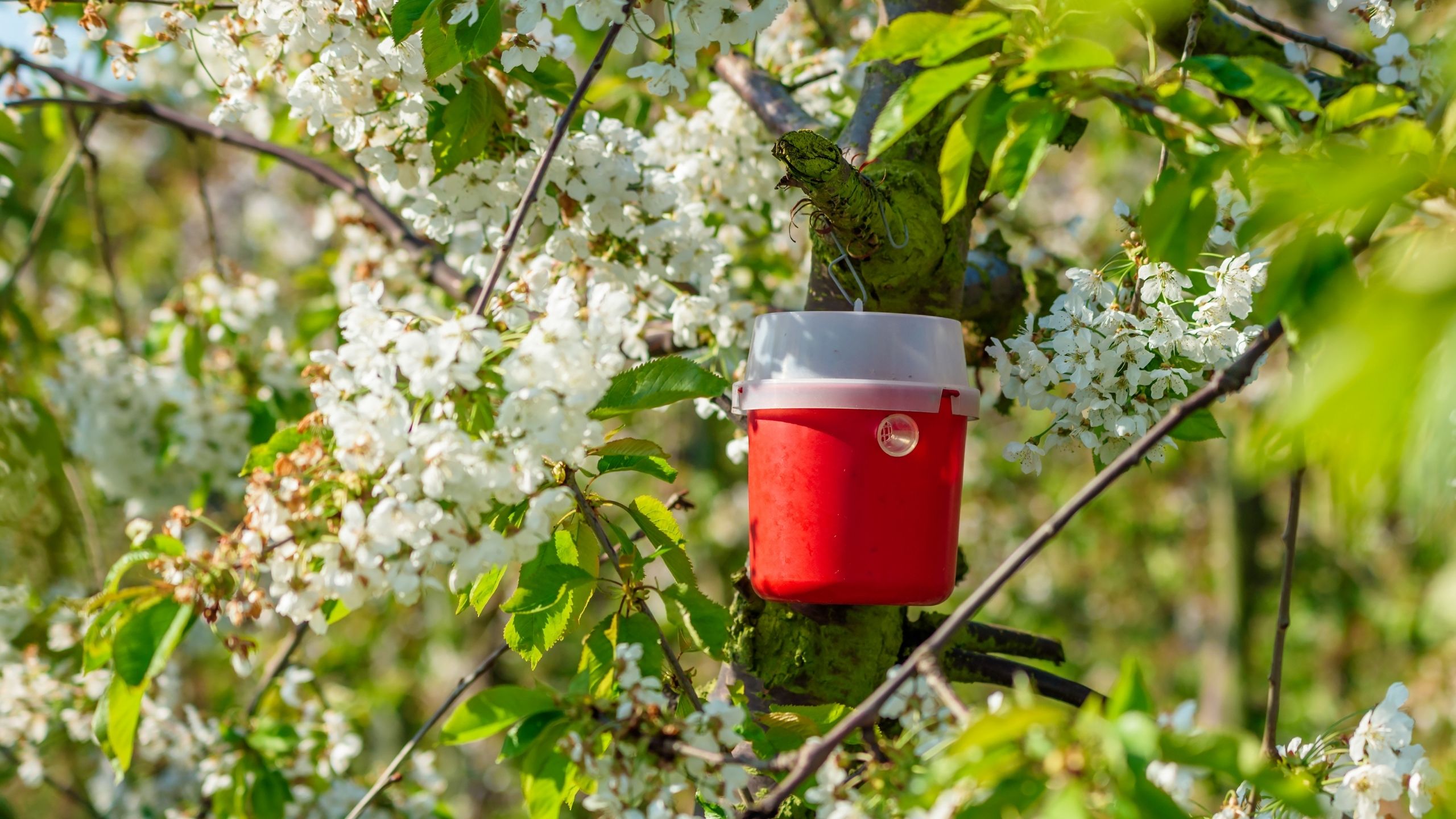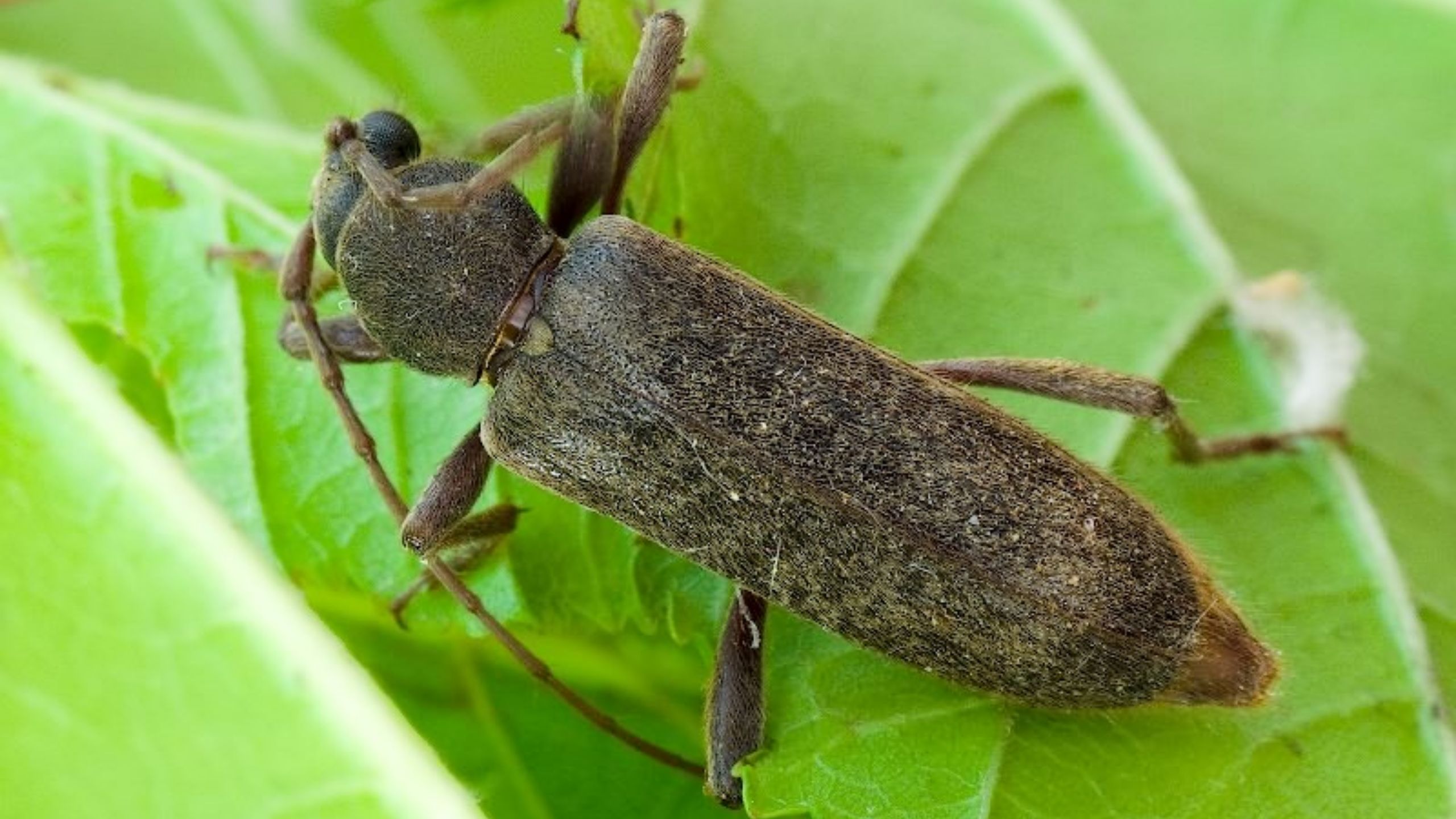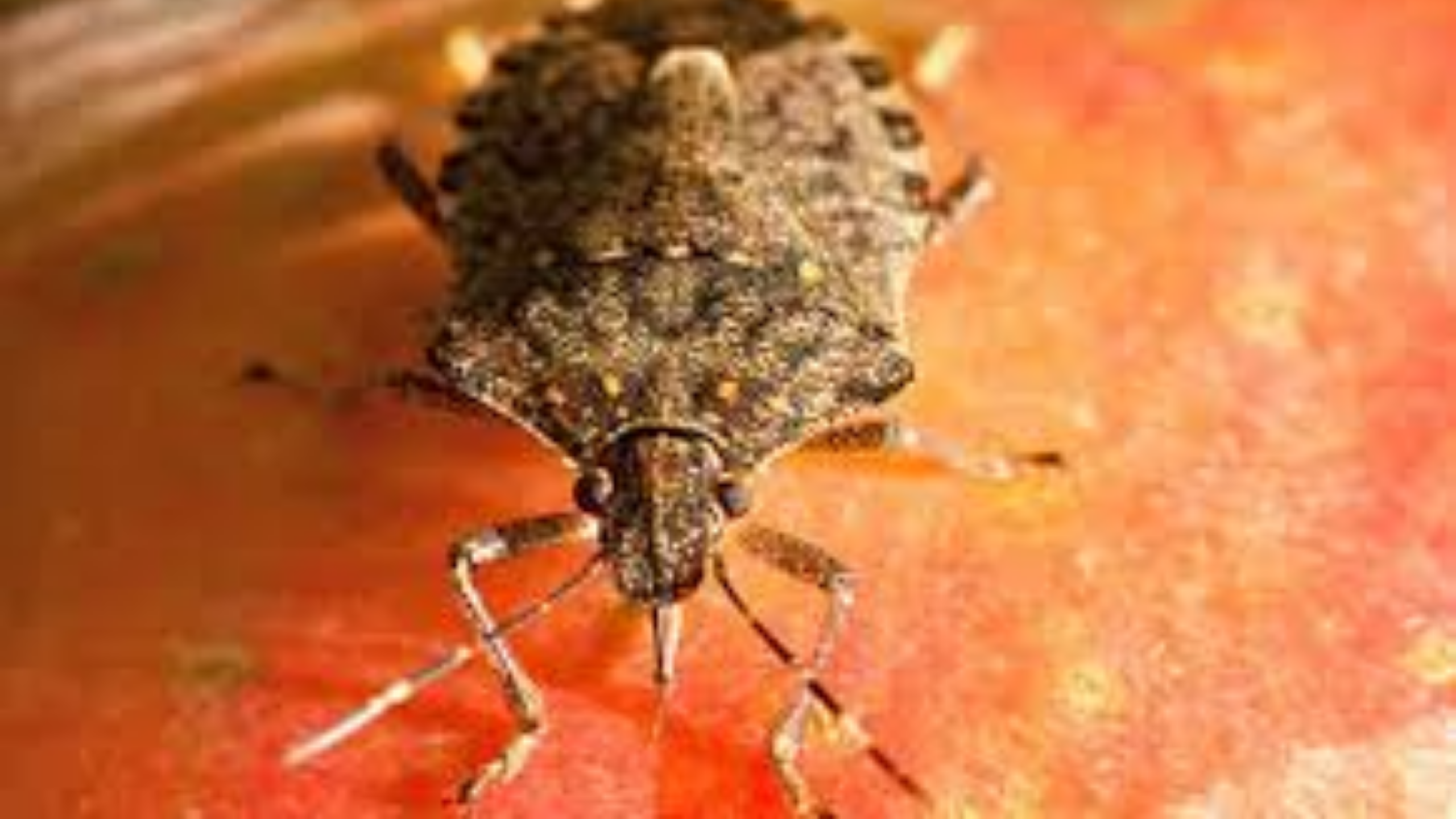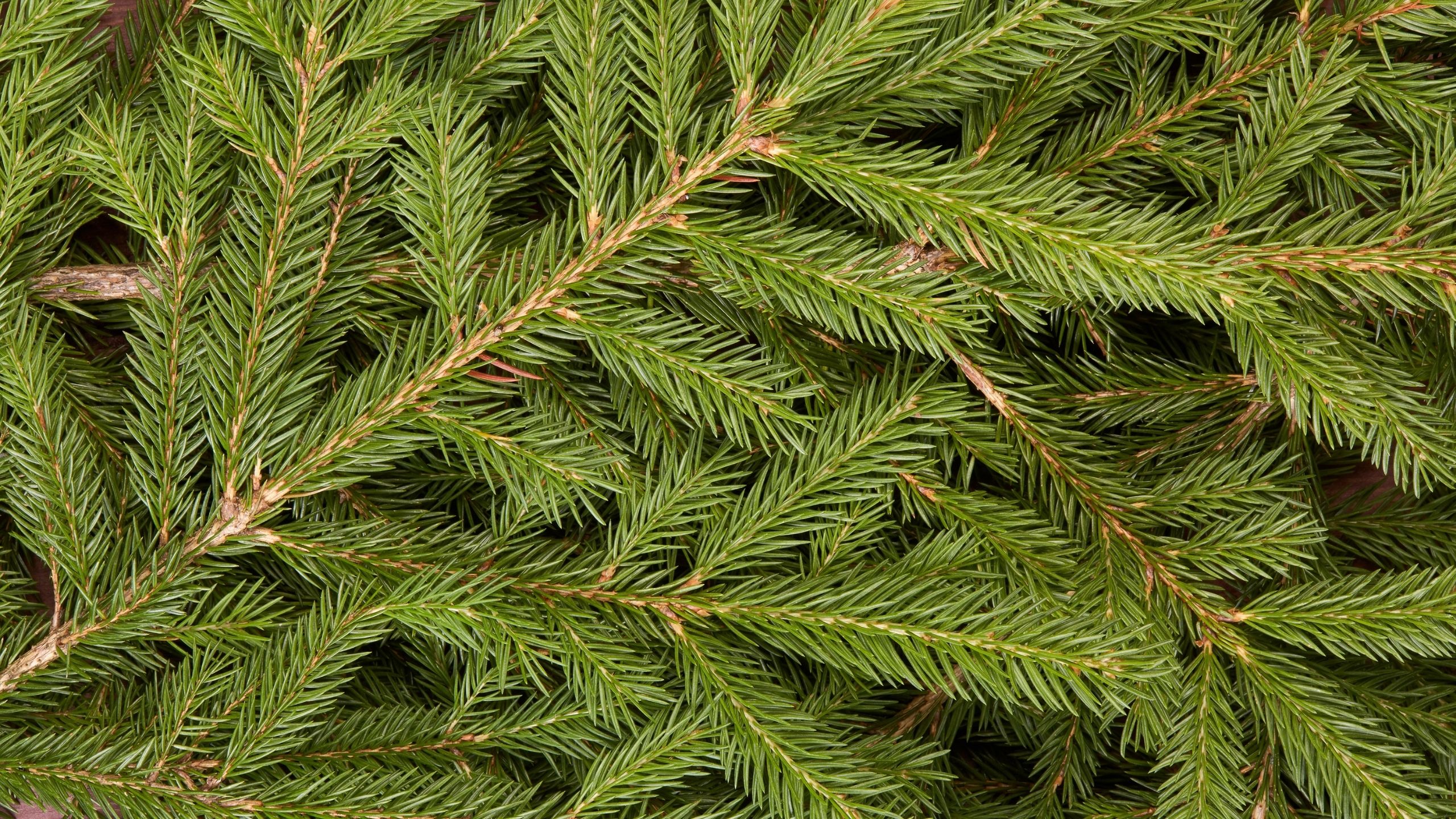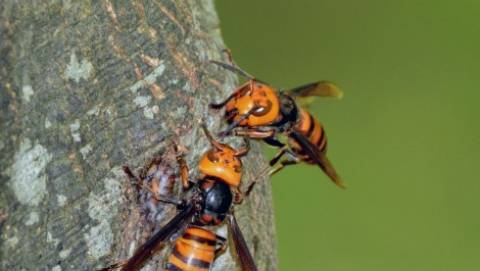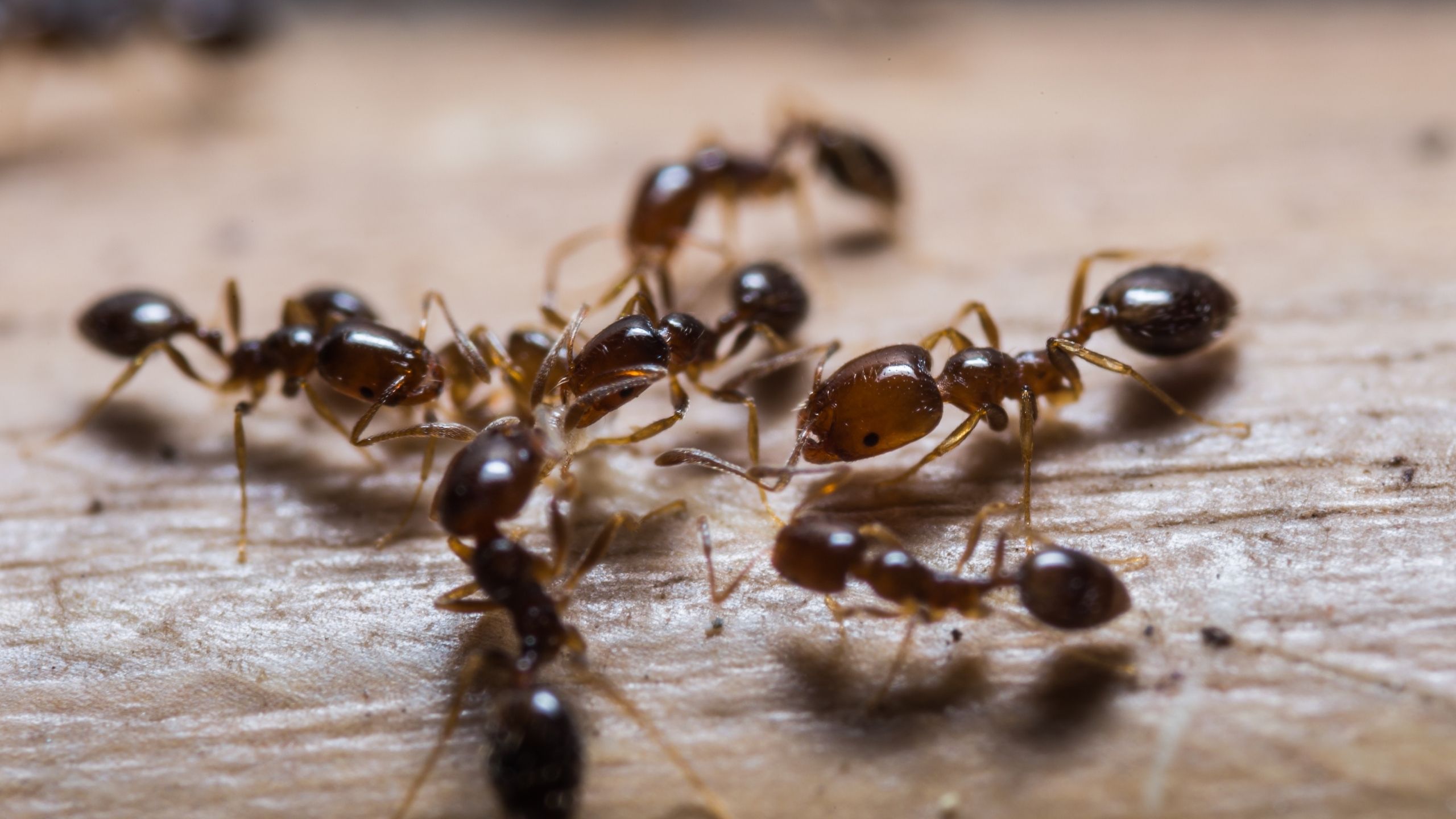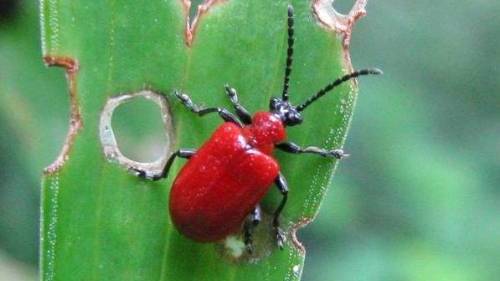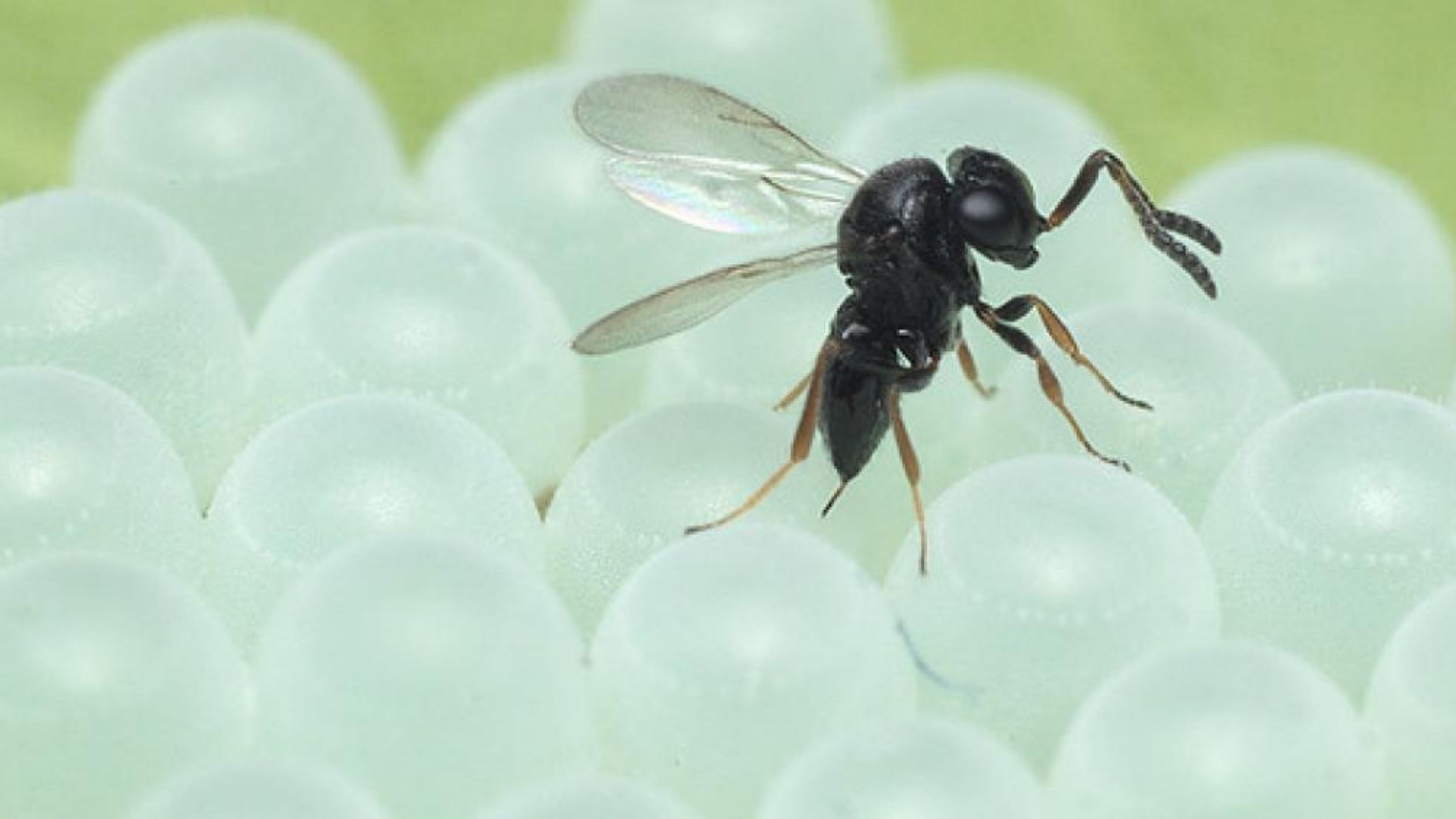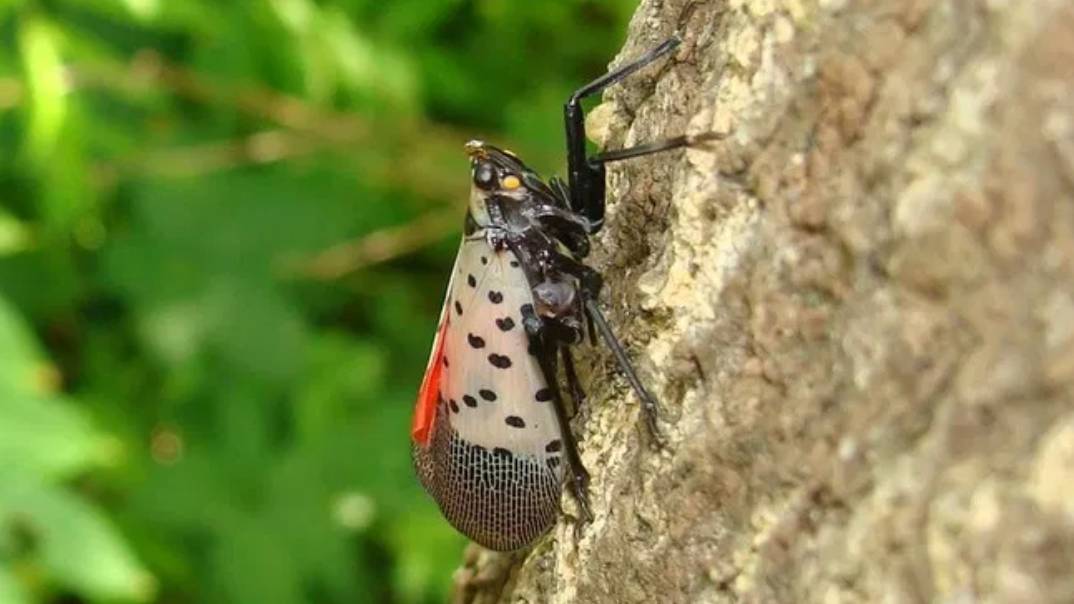Lily Leaf Beetle (Lilioceris lilii Scopoli)
September 2021
Ann Mull, Extension Assistant (No longer at USU) • Lori Spears, CAPS Coordinator (No longer at USU)
Quick Facts
- Lily leaf beetle (LLB) is an introduced pest from Eurasia that causes damage to plants in the Liliaceae family.
- Native and cultivated Lilium and Fritillaria species are sensitive to attack, including rare and endangered species.
- Daylilies (Hemerocallis spp.) are not at risk for attack.
- This is the only Lilioceris beetle known in North America. It is not known to occur in Utah.
- LLB can cause economic and aesthetic losses for commercial lily growers and home gardeners.
- The larval stage causes the most damage, but both adults and larvae can completely defoliate host plants without control measures in place.
- In its native range, populations are kept under control by native parasitoids and predators that have coevolved with LLB. In the northeastern U.S., wasp parasitoid specialists have been successfully introduced for control of LLB.
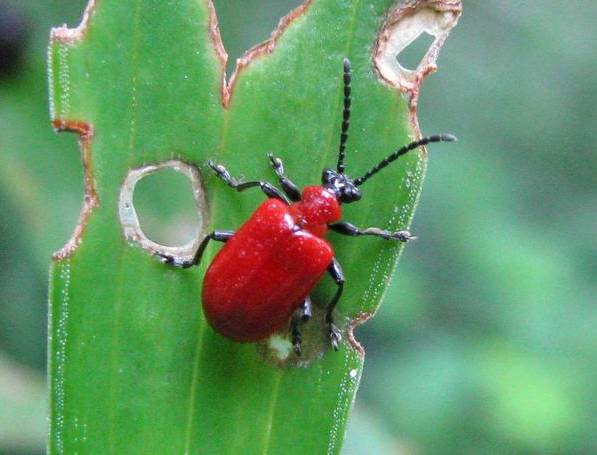
Fig. 1. Lily leaf beetle adult. Image courtesy of Leslie J. Mehrhoff, University of Connecticut, Bugwood.org.
Description
Adults (Figs. 1 to 3) are from 1/4 inch to 3/8 inch (6 to 9.5 mm) in length. The thorax and abdomen are shiny and scarlet red in color with tiny dimples, whereas the head, legs, antennae, and undersides are black. Adults readily drop from the host plant when disturbed and play dead as they lay upside down on the ground surface. They make a shrill sound (stridulate) when squeezed (Liesch & Johnson, 2020).
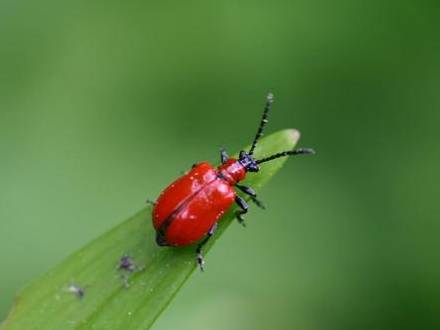
Fig. 2. LLB adult. Image courtesy of Leslie J. Mehrhoff, University of Connecticut, Bugwood.org.

Fig. 3. LLB adults feeding. Image courtesy of Leslie J. Mehrhoff, University of Connecticut, Bugwood.org.
Larvae (Fig. 4) are plump, squishy, and sluglike, with black heads and orange, yellow, brown, or rarely green bodies. They cover their bodies with their own excrement and can resemble slimy greenish-brown slugs or a moving pile of animal feces (Liesch & Johnson, 2020). Larvae can reach up to about ½ inch (12 mm) in length when mature.
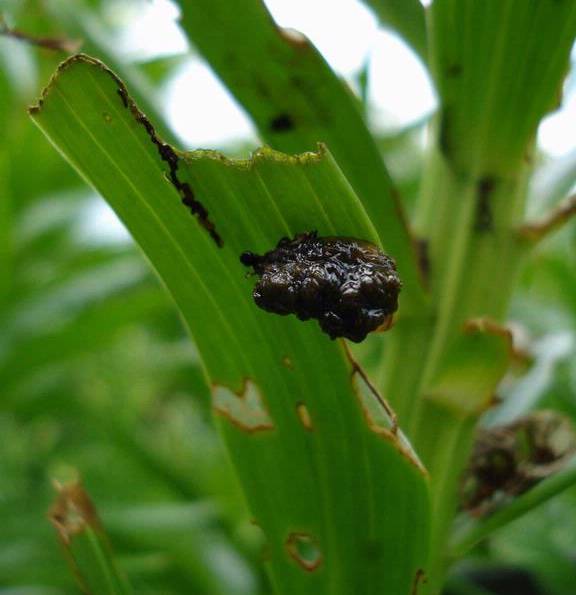

Fig. 4. LLB feces-covered larva feeding on Lilium spp. (left); LLB larvae feeding on host plant (right). Image courtesy of Kenneth R. Law, USDA APHIS PPQ, Bugwood.org (left); Leslie J. Mehrhoff, University of Connecticut, Bugwood.org (right).
Pupae are bright orange and encased in a whitish silk-like cocoon about 5/16 inches (9 mm) in length and made from saliva (Fig. 5).


Fig. 5. LLB pupa (left) and cocoon (right). Image courtesy of Rose Hiskes, Connecticut Agriculture Experiment Station (left); Richard A. Casagrande, University of Rhode Island, Bugwood.org (right).
Eggs are tiny and irregularly shaped and about 1/10 inch in length. They are bright scarlet red to reddish-orange (Fig. 6) and darken as they mature.
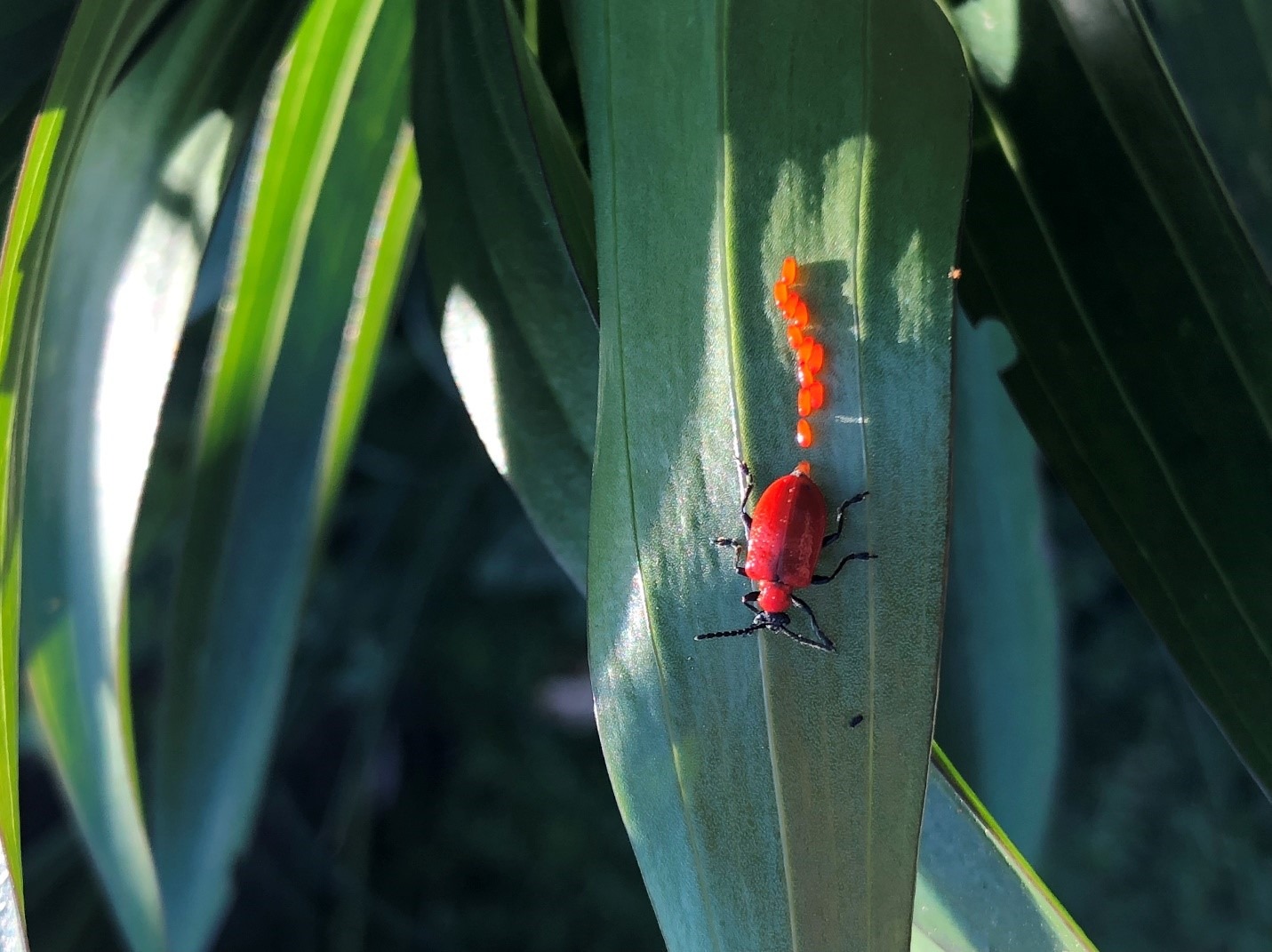

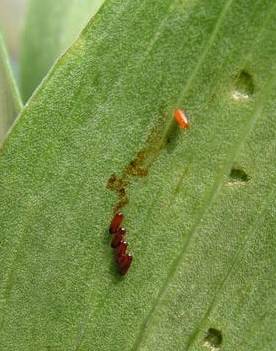
Fig. 6. Adult LLB laying eggs (left); LLB eggs (center and right). Eggs darken as they mature (right). Image courtesy of Karly Fifarek (left); Bruce Watt, University of Maine, Bugwood.org (center and right).
Plant Hosts
Adults and larvae can cause economic losses as they feed on plants in the Liliaceae family (true lilies), including both native and cultivated lily varieties (Lilium spp.) such as Turk’s cap lily (L. superbum), Easter lily (L. longiflorum), Asiatic lily (L. asiatica), Oriental lily (L. spp.), tiger lily (L. lancifolium), and their hybrids, as well as fritillaries (Fritillaria spp.), giant lily (Cardiocrinum giganteum), Canada mayflower (Maianthemum canadense), and cultivated onion (Allium cepa). Adults can be found resting or feeding on non-Liliaceae plants such as Solomon’s seal (Polygonatum spp.), lily of the valley (Convallaria majalis), various hosta species (Hosta spp.), bittersweet nightshade (Solanum dulcamara), potato (Solanum spp.), hollyhock (Alcea spp.), flowering tobacco (Nicotiana spp.) and Smilax spp., but LLBs neither reproduce on these plants nor cause significant damage to them. Daylilies (Hemerocallis spp.), canna lilies (Canna spp.) and calla lilies (Calla spp.) are not true lilies and are not at risk for attack. LLB could potentially affect Utah’s state flower, the sego lily (Calochortus nuttallii), and Utah’s native yellow fritillaries (F. pudica) if its range expands into Utah forests (Freeman et al., 2020).
Damage Symptoms
Adults and larvae create irregular holes and notches in leaves, stems, and developing buds of host plants as they feed, and severe feeding damage can result in destroyed flowers and severe plant defoliation (Figs. 7 and 8). Early summer attacks can result in undersized bulbs that may not flower the following year (RHS, n.d.), and weakened plants may become more susceptible to pathogens such as Botrytis leaf blight and lily gray mold (Botrytis elliptica).

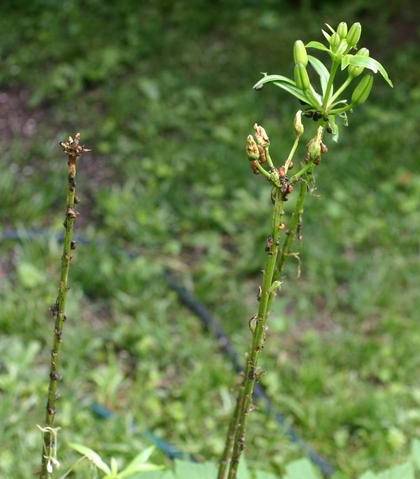
Fig. 7. LLB larvae and damage caused from their feeding (left and right). Image courtesy of Maggie Freeman, Washington State Department of Agriculture (left); Leslie J. Mehrhoff, University of Connecticut, Bugwood.org (right).
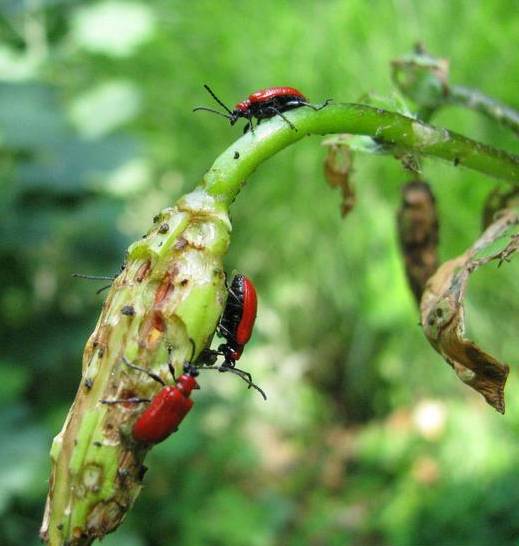
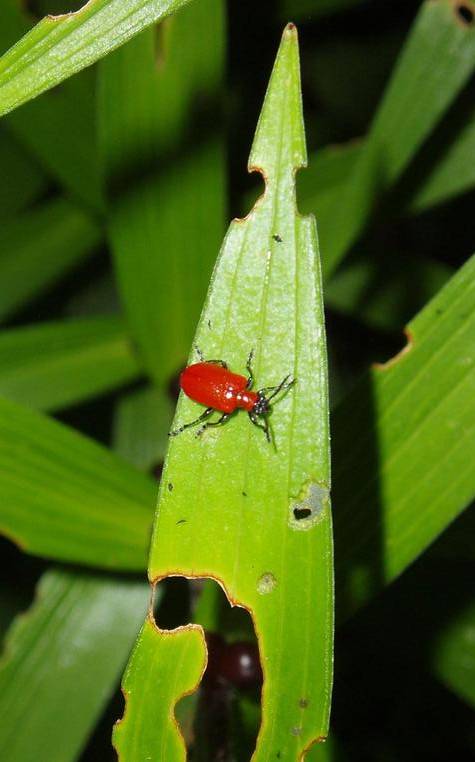
Fig. 8. LLB feeding damage on flower heads (left); feeding damage on leaves (right). Image courtesy of Leslie J. Mehrhoff, University of Connecticut, Bugwood.org (both).
Life History
LLB adults overwinter and emerge in early spring when the first lily leaves appear and begin actively feeding on foliage and searching for a mate. After feeding for 2 to 3 weeks, mated females lay from 2 to 16 eggs at a time (averaging about 12) in one or more rows parallel to a leaf vein on the underside of leaves and on flower buds or open flowers. Feeding and egg production continues until late summer or as long as fresh lily leaves are available. The eggs hatch in 6 to 7 days at 72 °F (22 °C), and the developing larvae typically cover their bodies with a thick protective barrier of frass (insect feces) as they feed, giving them the appearance of mobile piles of excrement. Larvae undergo four larval stages (instars) over 2 to 3 weeks. First instar larvae typically begin feeding as a group on a leaf’s under surface and gradually move to the upper surface and buds as they develop. The later instars feed on the entire leaf, beginning at the margin of lower leaves and moving upwards on the plant as new growth occurs. Leaves, flowers, stems, and buds can be consumed, and both adults and larvae can be found feeding together. Mature larvae drop to the ground and use saliva and soil to build a cocoon and pupate in the soil, and the new adults typically emerge 2 to 3 weeks later in summer to feed before finding overwintering sites. Adults overwinter in the fall in soil, litter, or debris, not necessarily near host plants. One generation occurs per year (univoltine). Adults can live for several years, and each female can lay from 250 to 450 eggs in her lifetime. Adults can fly long distances to locate host plants, preferring areas that are protected, shaded, cool, and moist. They can be found on lilies throughout the growing season (CABI, 2020; Liesch & Johnson, 2020; Valerio, 2016).
Monitoring
Monitor host plants throughout the growing season for the presence of adults, larvae, eggs, and feeding damage. Check plants for adult LLBs beginning in spring when lilies and fritillaries emerge. Look for eggs on the underside of leaves beginning in April and frass-covered larvae in midsummer. When you see adults on a plant, turn over its leaves and inspect for rows of eggs. If you suspect LLB in Utah, contact the Utah Plant Pest Diagnostic Lab. When looking for LLBs, keep in mind that Utah is home to some native insects that have a similar appearance (Fig. 9). Such lookalikes include the red-femured milkweed beetle (Tetraopes femoratus), which feeds exclusively on milkweed and can also stridulate; the red flat bark beetle (Cucujus clavipes), which feeds on insects inside trees; a blister beetle (Nemognatha lurida), which feeds on thistle and composites; and the boxelder bug (Boisea trivittata), which is a common native species in Utah.




Fig. 9. LLB lookalikes in Utah include (left to right) the red-femured milkweed beetle, the red flat bark beetle, a blister beetle, and adult and immature boxelder bugs. Image courtesy of (from left to right): Whitney Cranshaw, Colorado State University, Bugwood.org; Bruce Watt, University of Maine, Bugwood.org; Kansas Department of Agriculture, Bugwood.org; William M. Ciesla, Forest Health Managment International, Bugwood.org.
Management
Currently, the most practical approaches for controlling LLB are to prevent them from occurring in the first place and eradicate individuals before they spread to new areas. LLB has not been detected in Utah, so there is no current need for control of this insect. Since all control options rely on proper identification of the pest species, please contact the Utah Plant Pest Diagnostic Lab if you suspect LLB in Utah. The following content is for informational purposes.
Cultural Control
- Handpick individuals from plants. Handpicking adults, larvae, and eggs is an effective means of reducing LLB damage. As described in the “Monitoring” section, begin searching for LLBs in April and continue throughout the growing season, and check the underside of leaves for egg masses, especially when adults are present. Since the larvae cover themselves with insect feces, consider wearing gloves as you remove them from host plants.
- Choose resistant or tolerant plants. Nearly all lily species and cultivars are susceptible to LLB. Choose resistant plants if LLB has been detected in your area. Asiatic hybrids have shown susceptibility to LLB, while some Oriental lilies and hybrids such as Lilium henryi ‘Madame Butterfly’, L. speciosum ‘Uchida’, L. ‘Black Beauty’, L. regale, and L. ‘Golden Joy’ have shown some resistance (Murray, et al. 2014; Stack et al., 2009). The lily ‘Defender Pink’ is advertised as LLB tolerant (RHS, n.d.; Salisbury et al. 2009).
Biological Control
There are no known effective native enemies of LLB in North America, but three species of tiny European parasitoid wasps that are specific to the genus Lilioceris have been successfully introduced in the northeastern U.S.: Tetrastichus setifer, Lemophagus errabundus, and Diaparsis jucunda (Tewksbury et al., 2017). These wasps lay eggs inside LLB larvae, and the developing wasps use their LLB hosts as both food and shelter (Fig. 10). The parasitized LLB larva will drop to the ground to pupate, and in the spring, the wasp emerges from the body of its dead host (Valerio et al., 2016). Currently, these parasitoids are not known to occur in Utah. A related parasitoid wasp, Tetrastichus julis, occurs in our state and targets a close relative of LLB, the invasive cereal leaf beetle (Oulema melanopus) (Evans, 2018), but it is not known to attack LLB (Kher et al., 2013).
In areas where these LLB parasitoids are known to exist, minimize mulching of lily beds and avoid digging up lily bulbs. Soil is a better shelter for overwintering parasitoids than mulch, so in areas where these parasitoids exist, avoid disturbing the soil to encourage their success, especially in private gardens (CABI, 2020; Tewksbury et al., 2017; Valerio et al., 2016).
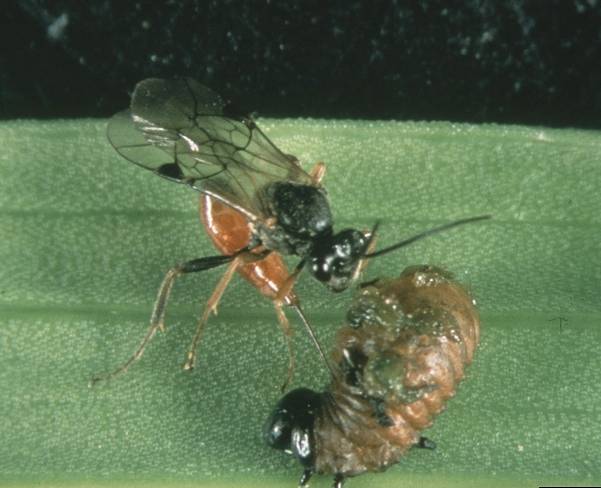
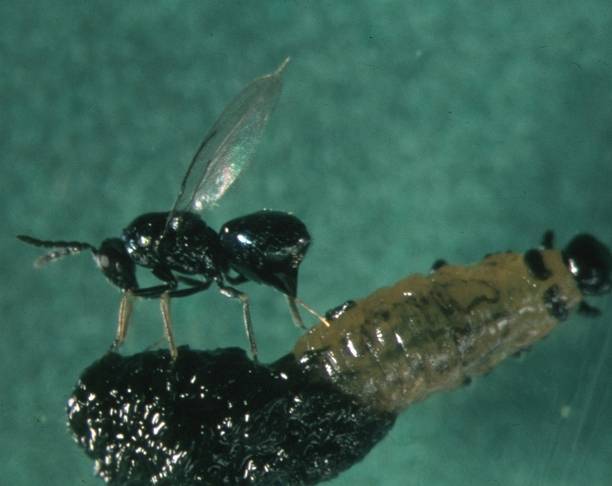
Fig. 10. LLB larvae being parasitized by D. jucunda (left) and T. setifer (right). Image courtesy of Tim Haye, Universität Kiel, Bugwood.org (both images).
Chemical Control
Azadirachtin (neem oil) and insecticidal soaps have shown some control of LLB when applied every 5 to 7 days after egg hatch. Systemic insecticides, such as imidacloprid, may provide effective control as a foliage spray or soil drench, depending on the label instructions, but note that imidacloprid and other insecticides must not be applied to plants in bloom or when bees are active. Contact insecticides that are effective against larvae contain the active ingredients permethrin, cyhalothrin, deltamethrin, or pyrethrin (Saeed, 2017; Smith, 2013). In general, insecticides with shorter persistence are less damaging to nontarget species than those with longer persistence and/or systemic action. If chemical control is warranted, give preference to the less toxic chemicals such as insecticidal soaps and azadirachtin, and apply late in the day or early in the morning when bees are not active.
References and Further Reading
- CABI. (2020). Lilioceris lilii (lily leaf beetle). Invasive Species Compendium, CAB International.
- EDDMapS. (2021). Early detection and distribution mapping system. The University of Georgia Center for Invasive Species and Ecosystem Health.
- Evans, E. W. (2018). Dispersal in host-parasitoid interactions: Crop colonization by pests and specialist enemies. Insects 9, 134.
- Freeman, M., Looney, C., Orlova-Bienkowskaja, M. J., & Crowder, D. W. (2020). Predicting the invasion potential of the lily leaf beetle, Lilioceris lilii Scopoli (Coleoptera: Chrysomelidae), in North America. Insects 11, 560.
- Kher, S. V., Dosdall, L. M., & Carcamo, H. (2013). Oulema melanopus (L.), cereal leaf beetle (Coleoptera: Chrysomelidae). In Biological Control Programmes in Canada 2001-2012, P. G. Mason and D. R. Gillespie, eds. pp. 233-238.
- Liesch, P. J. & Johnson, L. (2020). Lily leaf beetle. University of Wisconsin Extension.
- Murray, T. A., LaGasa, E., & Glass, J. (2014). Pest watch: Lily leaf beetle. [Fact Sheet FS084E]. Washington State University Extension.
- RHS. (n.d.). Lily beetle: Lilies (Lilium), giant lilies (Cardiocrinum) and fritillaries (Fritillaria) can be defoliated by lily beetle. Royal Horticultural Society.
- Saeed, A. (2017). Lily leaf beetle: Watch out for this garden pest. Michigan State University Extension.
- Salisbury, A., Clark, S. J., Powell, W., & Hardie, J. (2009). Susceptibility of six Lilium to damage by the lily leaf beetle, Lilioceris lilii (Coleoptera; Chrysomelidae). Annals of Applied Biology 156, 103-110.
- Smith T. (2013). Lily leaf beetle. Extension Greenhouse Crops and Floriculture Program, University of Massachusetts at Amherst.
- Stack, P. A., Groden, E., & Stack, L. B. (2009). Lily leaf beetle. [Bulletin #2450]. The University of Maine Cooperative Extension.
- Tewksbury, L., Casagrande, R. A., Cappuccino, N., & Kenis, M. (2017). Establishment of parasitoids of the lily leaf beetle (Coleoptera: Chrysomelidae) in North America. Environmental Entomology 46, 226-236.
- Valerio, R., Tewksbury, L., & Casagrande, R. (2016). Biological control of the lily leaf beetle. URI Biocontrol Lab, University of Rhode Island.



